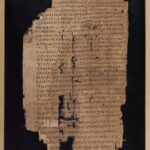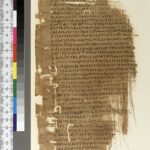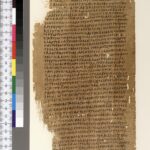| Artefact ID | 752 |
| TM ID | TM 61462 |
| Findspot (DEChriM ID) | - () | Class | Textual |
| Material | Papyrus |
| Writing medium | Codex |
| Text content | Literary |
| Language | Greek |
| Description | P.Beatty VIII 12 (XII); P.ChesterBeatty VIII 12 Papyrus codex containing Henoch, Apocalypse of Enoch and Melito of Sardes, Homilia on Easter. All in all, 14 folios are preserved, comprising pages 15-42 of a codex with Christian theological texts. From the Apocalypse of Enoch, the verses 97:6-104 and 106-107:3 are preserved along with an end-title. Folio 1 contains pages 15-16 (verso precedes recto; Beatty 100) P. Mich. inv. 5552 (Enoch) contains folios 3 (13.6 x 23.4 cm, 41 lines on page 19 and 39 lines of page 20) and 5 (43 lines on page 23 and 44 lines on page 24). These two folios of Enoch contain chapters 100:1-101:7 and 103:14-106:7. P. Mich. 5553 (Melito of Sardes) contains folios 7 (13.5 x 23.8 cm, 41 lines of page 27 and 42 lines on page 28), 9 (13.6 x 23.2 cm, 42 lines on page 31 and 37 lines on page 32), 10 (13.9 x 22.9 cm, 40 lines on page 33, and 38 lines on page 34) and 13 (13 x 22.9 cm, 40 lines on page 39 and 36 lines on page 40). The arrangement of text appears to have been as such: the concluding chapters of the Book of Enoch occupied the first six folios (11 and a half pages). The remaining 8 folios (including half of page 26 of folio 6) are occupied by the Homily on Easter by Melito of Sardes, which is introduced by the title Μαλείτων. Two additional folios (Beatty 185) present the text of the Apocryphon of Ezekiel. Parts of these works were previously known only through Latin, Ethiopic and Syriac traditions; see VanHaelst 1976: 679. The codex is estimated to have measured 27 x 13.5 cm originally. All three works, as well as the minor corrections, appear to have been written by the same scribe. The hand is described as a crude, but clear uncial, indicating that the scribe was not very practised. This is apparent i.a. in the variation of size and spacing of the letters. Although elision occurs frequently (there is an apparent attempt to avoid hiatus thoughout the text), it is indicated by apostrophe only once. There are no accents or breathings in the text. A strong form of punctuation appears in two places, where it is indicated by an enlarged space as well as a siglum marking the paragraph. The text contains diaereses (also internally in Μωϋσες and Ἠσαϊας, but additionally above the iota of the dative Μωϋσεϊ), and there appear several of the usual nomina sacra. |
| Selection criteria | Literary genre (Biblical), Literary genre (Non-canonical), Literary genre (Theological), Nomina sacra |
| Date from | 300 |
| Date to | 349 |
| Dating criteria | Palaeography. The hand is dated to the 4th c.; see the ed. pr. and the ref. ed., which is supported by Kenyon (Kenyon 1931) and Turner (Turner, Eric G. 1977. The Typology of the Early Codex. University of Pennsylvania Press. ). |
| Absolute/relative date | Relative date |
| Archaeological context | The provenance of the fragments is uncertain; see Kenyon 1931: 13. The P.Mich. inv. 5552 and 5553 were acquired by Mr. Peterson in the Fayûm in 1930, while the P.Beatty fragments (100-185 passim) were part of an acquisition by Sir Chester Beatty in 1930-31. Aphroditopolis (Atfih, by Schmidt), Upper Egypt or Panopolis (by Sanders) and the Arsinoites (Fayûm, by Kilpatrick) are mentioned as a possible provenance; see the overview of Van Haelst 1976: 30. |
| Accession number | Ann Arbor, Michigan University, Library P. 5552 + P. 5553 + Dublin, Chester Beatty Library P.Bibl. 12 (previously: Ac. 100, 167 - 173, and 185) |
ARTEFACT IDENTIFIERS
Reference edition:
• Kenyon, Frederic G. 1941. Chester Beatty Biblical Papyri VIII, Enoch and Melito. Plates. London. Papyrus no. 12.
Editio princeps:
• Bonner, Campbell. 1940. The Homily on the Passion by Melito with some fragments of the apocryphal Ezekiel. London / Philadelphia. 1-202 and plate no. 1.
• Bonner, Campbell and Herbert C. Youtie. 1937. The last chapters of Enoch in Greek. London. 1-106 and plate no. I
Additional bibliography:
• Aland, Kurt. 1995. Repertorium der Griechischen Christlichen Papyri. II. Kirchenväter. Berlin. Kirchenväter 54.
• Aland, Kurt. 1976. Repertorium der griechischen christlichen Papyri: 1. Biblische Papyri: Altes Testament, Neues Testament, Varia, Apokryphen. Apokryphen 2 and 3.
• Bonner, Campbell. 1932. "New Biblical Papyri at the University of Michigan". HThR 25 (2). 205-206.
• Cavallo, Guglielmo, and Herwig Maehler. 1987. Greek bookhands of the early Byzantine period, A.D. 300-800. London: University of London, Institute of Classical Studies. Plate no. 3a.
• Cohick, L.C. 2000. The peri pascha attributed to Melito of Sardis. Brown Judaic Studies 327.
• Crisci, Edoardo. 2004. "I più antichi codici miscellanei greci. Materiali per una riflessione". Segno e Testo 2. 127-129 and plate no. 11.
• Crisci, Edoardo and Oronzo Pecere, eds. 2004. Il codice miscellaneo. Tipologie e funzioni. Atti del Convegno internazionale. Cassino 14–17 maggio 2003. 144, plate no. 11.
• Cross, F. L. 1960. "". Journal of Theological Studies 11 (1). 162.
• Drawnel, Henryk. 2019. Qumran cave. 4: The Aramaic books of Enoch, 4Q201, 4Q202, 4Q204, 4Q205, 4Q206, 4Q207, 4Q212. Oxford: Oxford University Press. 29-32.
• Hall, Stuart G. 1968. "The Melito Papyri". Journal of Theological Studies 19. 476-508.
• Kenyon, F. G. 1931. The Times. November the 19th. London. 13.
• Nongbri, Brent. 2018. God's library: the archaeology of the earliest Christian manuscripts. Newhaven: Yale University Press. 121, 132-133, 137 and 152.
• Perler, Othmar. 1966. Méliton de Sardes: Sur la Pâque et fragments. Paris: Éditions du Cerf.
• Pietersma, Albert. 1987. "New Greek Fragments of Biblical Manuscriptsin the Chester Beatty Library". Bulletin of the American Society of Papyrologists 24 (3/4). 40-45 and 50-53, papyrus no. 3.
• Turner, Eric G. 1977. The Typology of the Early Codex. University of Pennsylvania Press. 132 (no. 543).
• van Haelst, Joseph. 1976. Catalogue des papyrus littéraires juifs et chrétiens. Paris. Description no. 578, 579 and 677.
• Zuntz, Günther. 1942. "Notes on the Greek Enoch." JBL 61. 193-204.
• Zuntz, Günther. 1944. Enoch on the Last Judgement (Ch. CII, 1-3). The Journal of Theological Studies 45 (179/180). 161-70.


 Json data
Json data








